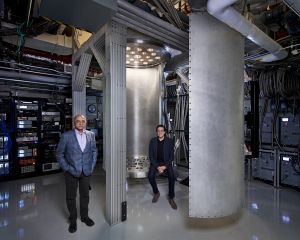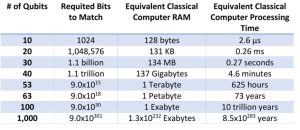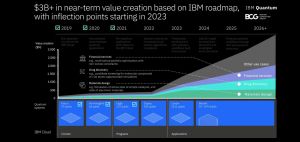Difference between revisions of "Darwin2049/ChatGPT4/PhaseShift"
Darwin2049 (talk | contribs) |
Darwin2049 (talk | contribs) |
||
| Line 29: | Line 29: | ||
'''''Quantum Computing.''''' Quantum computing is an abstruse topic area. Just the underpinning concepts can seem to be counterintuive and perplexing. Therefore what follows is intended to only be a cursory overview of some of the main features of this revolutionary area. Advanced mathematics is advised for those wishing to further understand the crucial elements of entanglement, coherence, vector spaces or quantum algorithms.<BR /> | '''''Quantum Computing.''''' Quantum computing is an abstruse topic area. Just the underpinning concepts can seem to be counterintuive and perplexing. Therefore what follows is intended to only be a cursory overview of some of the main features of this revolutionary area. Advanced mathematics is advised for those wishing to further understand the crucial elements of entanglement, coherence, vector spaces or quantum algorithms.<BR /> | ||
What can be said currently however is that this new computational environment will make possible solution to currently intractable problems soluble within acceptable time frames. The ability to do so will invariably carry with it great promise but also great risk. <BR /> | What can be said currently however is that this new computational environment will make possible solution to currently intractable problems soluble within acceptable time frames. The ability to do so will invariably carry with it great promise but also great risk. <BR /> | ||
[[File:IBMQ04.jpg| | [[File:IBMQ04.jpg|300px|right|IBM Lead Researchers]] | ||
[[File:IBMQ05.jpg| | [[File:IBMQ05.jpg|300px|right|Quantum system assembly 'chandelier' visible]] | ||
'''''Early Stages.''''' In reporting on the current state of the art of quantum computing the term ''coherence'' seems to arise regularly. This refers to the ability to maintain a consistent coherent quantum state that is sufficiently long for useful computation to occur and deliver results. <BR /> | '''''Early Stages.''''' In reporting on the current state of the art of quantum computing the term ''coherence'' seems to arise regularly. This refers to the ability to maintain a consistent coherent quantum state that is sufficiently long for useful computation to occur and deliver results. <BR /> | ||
| Line 39: | Line 39: | ||
Stepping into the near term future then we might think it reasonable to believe that the computing world will look much like it does today. But this would be an incorrect assumption. The advent of widespread quantum computing will represent a before/after event in human history.<BR /><BR /> | Stepping into the near term future then we might think it reasonable to believe that the computing world will look much like it does today. But this would be an incorrect assumption. The advent of widespread quantum computing will represent a before/after event in human history.<BR /><BR /> | ||
--> | --> | ||
[[File:IBMQ2.jpg| | [[File:IBMQ2.jpg|right|300px|IBM Quantum System 2]] | ||
<!-- | <!-- | ||
| Line 46: | Line 46: | ||
* '''''<SPAN STYLE="COLOR:BLUE">Cognitive prosthetic based quantum systems will completely eclipse current incarnations of all existing CG4 based systems5:</SPAN>''''' Quantum computing devices are already demonstrating their ability to solve problems in seconds or minutes that classical von Neuman computing machines require decades, centuries or even millennia to solve. The departure from classical computing using collections of zero or one binary digits is severely limited when compared to how logic can be represented using quantum bits (qubits). With qubits large numbers of simultaneous true/false states can exist simultaneously. This is inherent within the realities of quantum mechanics. The interested observer is advised to pursue a more in depth study of the subject of quantum mechanics, entanglement, uncertainty, particle/wave duality as well as the other fundamental features that are known to operate at the quantum level. | * '''''<SPAN STYLE="COLOR:BLUE">Cognitive prosthetic based quantum systems will completely eclipse current incarnations of all existing CG4 based systems5:</SPAN>''''' Quantum computing devices are already demonstrating their ability to solve problems in seconds or minutes that classical von Neuman computing machines require decades, centuries or even millennia to solve. The departure from classical computing using collections of zero or one binary digits is severely limited when compared to how logic can be represented using quantum bits (qubits). With qubits large numbers of simultaneous true/false states can exist simultaneously. This is inherent within the realities of quantum mechanics. The interested observer is advised to pursue a more in depth study of the subject of quantum mechanics, entanglement, uncertainty, particle/wave duality as well as the other fundamental features that are known to operate at the quantum level. | ||
[[File:BlochSphere00.png| | |||
[[File:BlochSphere00.png|300px|right|Bloch Sphere]][[File:QU-BIT04.jpg|500px|left|Binary vs. Quantum Logic]] | |||
Note that with binary logic there are only two possible definite values possible: zero or one, true or false. With quantum reality there are innumerable states in between that describe what a possible outcome can result in.<BR /><BR /> | Note that with binary logic there are only two possible definite values possible: zero or one, true or false. With quantum reality there are innumerable states in between that describe what a possible outcome can result in.<BR /><BR /> | ||
A brief glance at a '''''Bloch Sphere''''' makes a bit more clear that there are innumerable possible states between zero and one, true or false. These specific states are described by two complex numbers. <BR /><BR />Further they are described as residing within a unit sphere. This means that the unit sphere can be rotated on either of either the '''''x-axis''''' or the '''''y-axis'''''. In each case the ultimate value obtained will reside somewhere between zero and one. Recall that in each case the axis along either axis is described as being a complex number. | A brief glance at a '''''Bloch Sphere''''' makes a bit more clear that there are innumerable possible states between zero and one, true or false. These specific states are described by two complex numbers. <BR /><BR />Further they are described as residing within a unit sphere. This means that the unit sphere can be rotated on either of either the '''''x-axis''''' or the '''''y-axis'''''. In each case the ultimate value obtained will reside somewhere between zero and one. Recall that in each case the axis along either axis is described as being a complex number. | ||
--> | --> | ||
[[File:QU-BIT02.jpeg| | [[File:QU-BIT02.jpeg|300px|right|Quantum computing elements]] | ||
* '''''<SPAN STYLE="COLOR:BLUE">Phase Shift: Gas, Liquid, Solid.</SPAN>''''' Classical physics describes how states of matter possess different properties depending upon their energy state or environment. Thus on the surface of the earth we can experience the gas of the atmosphere. In environments that are somewhat above the freezing point of water we are unaware of the fact that we inhale and exhale atmospheric gas. It is odorless, colorless and tasteless. <BR /> | * '''''<SPAN STYLE="COLOR:BLUE">Phase Shift: Gas, Liquid, Solid.</SPAN>''''' Classical physics describes how states of matter possess different properties depending upon their energy state or environment. Thus on the surface of the earth we can experience the gas of the atmosphere. In environments that are somewhat above the freezing point of water we are unaware of the fact that we inhale and exhale atmospheric gas. It is odorless, colorless and tasteless. <BR /> | ||
'''''<SPAN STYLE="COLOR:BLUE">Gas.</SPAN>''''' Were we to collect sufficient quantities of atmospheric gas into a sealable container it would be possible to cool the gasses comprising earth's atmosphere into liquids. The idea of wetness, shape conformability and other properties of a liquid would suddenly become evident. Yet it would be difficult to adduce wetness if we never had experience with a liquids.<BR /> '''''<SPAN STYLE="COLOR:BLUE">Liquid.</SPAN>''''' If one never had contact with the liquid state of H2O then properties as buoyancy, wetness, conformability (i.e. to the shape of a container, evaporation, discoloration and similar properties might be very difficult to imagine. It would be difficult if not even impossible to envision something that was otherwise undetectable because it was odorless, colorless and tasteless could somehow cause one's death by drowning. Yet were one to be plunged into a large enough body of water but not possess swimming skills one could very well die by drowning. <BR /> | '''''<SPAN STYLE="COLOR:BLUE">Gas.</SPAN>''''' Were we to collect sufficient quantities of atmospheric gas into a sealable container it would be possible to cool the gasses comprising earth's atmosphere into liquids. The idea of wetness, shape conformability and other properties of a liquid would suddenly become evident. Yet it would be difficult to adduce wetness if we never had experience with a liquids.<BR /> '''''<SPAN STYLE="COLOR:BLUE">Liquid.</SPAN>''''' If one never had contact with the liquid state of H2O then properties as buoyancy, wetness, conformability (i.e. to the shape of a container, evaporation, discoloration and similar properties might be very difficult to imagine. It would be difficult if not even impossible to envision something that was otherwise undetectable because it was odorless, colorless and tasteless could somehow cause one's death by drowning. Yet were one to be plunged into a large enough body of water but not possess swimming skills one could very well die by drowning. <BR /> | ||
| Line 57: | Line 59: | ||
'''''<SPAN STYLE="COLOR:BLUE">Solid.</SPAN>''''' The process can be repeated. If we were to use water as a basis then we might discover another state of matter that water can exhibit. This is the state of ice. Many of us use this material (ice) to condition our beverages. That a heretofore wet liquid could become solid might also defy our ability to imagine it taking on solid form. These all consist of the same substance, i.e. H2O. Yet properties found in one state, or phase bear little or no resemblance to those in the subsequent state. We should expect to see an evolution comparable happening in fast forward motion that is very comparable to "gas to liquid, liquid to solid". When DeepMind or CG4 are re-hosted in a quantum computing environment equally unimaginable capabilities will become the norm.<BR /><BR /> | '''''<SPAN STYLE="COLOR:BLUE">Solid.</SPAN>''''' The process can be repeated. If we were to use water as a basis then we might discover another state of matter that water can exhibit. This is the state of ice. Many of us use this material (ice) to condition our beverages. That a heretofore wet liquid could become solid might also defy our ability to imagine it taking on solid form. These all consist of the same substance, i.e. H2O. Yet properties found in one state, or phase bear little or no resemblance to those in the subsequent state. We should expect to see an evolution comparable happening in fast forward motion that is very comparable to "gas to liquid, liquid to solid". When DeepMind or CG4 are re-hosted in a quantum computing environment equally unimaginable capabilities will become the norm.<BR /><BR /> | ||
[[File:HadamardSphere.png|650px|right|Hadamard Sphere]] | [[File:HadamardSphere.png|650px|right|Hadamard Sphere]] | ||
'''''<SPAN STYLE="COLOR:BLUE">Superposition.<SPAN />''''' Quantum computers are capable of performing calculations that are beyond the scope of classical computing devices. This arises from the quantum reality of superposition. This means that an object at the quantum level has two factors that can be measured: momentum and location. At any instant a quantum system can be in all possible definable states. The act of attempting a measurement will result in the collapse of this superposition state and result in returning a specific value. But this also means that only one factor can be known at the moment of measurement EITHER the position of the object or its momentum - but not both. This arises due to the Heisenberg's Uncertainty Principle. | |||
'''''<SPAN STYLE="COLOR:BLUE">Coherence.<SPAN />''''' A crucial factor that conditions the utility of a device operating at the quantum level is noise. Any kind of noise from heat, vibration or cosmic rays can disrupt the extremely delicate processes at the quantum level. Therefore when numbers are presented they are often not well differentiated into qubits that can perform useful computations relative to those that do not. A strategy for dealing with this problem has been to use large numbers of qubits as an error correcting means. Therefore when a quantum device is said to consist of over a thousand qubits then in fact it might have to use 90% of them just for maintaining quantum coherence and entanglement. In order to get meaningful results these quantum states must be maintained for the duration of the calculation. But at these levels and using this means the result is that calculations happen at scales far beyond merely electronic or even photonic speed but due to quantum realities multiple evaluations can happen in parallel. The result has been the dramatic speed up numbers that have recently been reported in various research labs and corporations. Therefore a quantum computer that is claiming to have one hundred or more coherent qubit capability means that they can outperform classical computers by very wide margins.<BR /><BR /> | '''''<SPAN STYLE="COLOR:BLUE">Coherence.<SPAN />''''' A crucial factor that conditions the utility of a device operating at the quantum level is noise. Any kind of noise from heat, vibration or cosmic rays can disrupt the extremely delicate processes at the quantum level. Therefore when numbers are presented they are often not well differentiated into qubits that can perform useful computations relative to those that do not. A strategy for dealing with this problem has been to use large numbers of qubits as an error correcting means. Therefore when a quantum device is said to consist of over a thousand qubits then in fact it might have to use 90% of them just for maintaining quantum coherence and entanglement. In order to get meaningful results these quantum states must be maintained for the duration of the calculation. But at these levels and using this means the result is that calculations happen at scales far beyond merely electronic or even photonic speed but due to quantum realities multiple evaluations can happen in parallel. The result has been the dramatic speed up numbers that have recently been reported in various research labs and corporations. Therefore a quantum computer that is claiming to have one hundred or more coherent qubit capability means that they can outperform classical computers by very wide margins.<BR /><BR /> | ||
'''''<SPAN STYLE="COLOR:BLUE">Wave-Particle Duality.<SPAN />''''' | '''''<SPAN STYLE="COLOR:BLUE">Wave-Particle Duality.<SPAN />''''' | ||
| Line 66: | Line 68: | ||
'''''<SPAN STYLE="COLOR:BLUE">[https://www.wikiwand.com/en/Uncertainty_principle Heisenberg's Uncertainty Principle].<SPAN />''''' Werner Heisenberg was the developer of the now famous [https://www.youtube.com/watch?v=m7gXgHgQGhw Heisenberg Uncertainty Principle] and won the Nobel prize for his discovery in 1927. His principle essentially stated that at the micro level of reality (i.e. atomic or subatomic) one can only measure the position OR the momentum of a particle. But because of the particle/wave duality nature of all matter it is impossible to measure both. Should we attempt to pinpoint the location of a particle we might discover its precise point at a specific moment in time but we can NOT know its momentum. Conversely we might measure its momentum or energy state but we can NOT know its position. The reality of the world at the quantum level is inherently counterintuitive. However innumerable physics experiments have demonstrated beyond doubt that this is the reality in which all material objects exist. | '''''<SPAN STYLE="COLOR:BLUE">[https://www.wikiwand.com/en/Uncertainty_principle Heisenberg's Uncertainty Principle].<SPAN />''''' Werner Heisenberg was the developer of the now famous [https://www.youtube.com/watch?v=m7gXgHgQGhw Heisenberg Uncertainty Principle] and won the Nobel prize for his discovery in 1927. His principle essentially stated that at the micro level of reality (i.e. atomic or subatomic) one can only measure the position OR the momentum of a particle. But because of the particle/wave duality nature of all matter it is impossible to measure both. Should we attempt to pinpoint the location of a particle we might discover its precise point at a specific moment in time but we can NOT know its momentum. Conversely we might measure its momentum or energy state but we can NOT know its position. The reality of the world at the quantum level is inherently counterintuitive. However innumerable physics experiments have demonstrated beyond doubt that this is the reality in which all material objects exist. | ||
[[File:IBMQUANTUM2.jpg| | [[File:IBMQUANTUM2.jpg|right|300px|Exponential Computational Capabilities]] | ||
The interested observer can find a number of useful references addressing the '''''<SPAN STYLE="COLOR:BLUE">topics of quantum bits, entanglement and superposition <SPAN />''''' | The interested observer can find a number of useful references addressing the '''''<SPAN STYLE="COLOR:BLUE">topics of quantum bits, entanglement and superposition <SPAN />''''' | ||
*'''''<SPAN STYLE="COLOR:BLUE">[https://quantumtech.blog/2021/11/14/quantum-superposition-and-entanglement/ The Quantum Leap]<SPAN> ''''' | *'''''<SPAN STYLE="COLOR:BLUE">[https://quantumtech.blog/2021/11/14/quantum-superposition-and-entanglement/ The Quantum Leap]<SPAN> ''''' | ||
| Line 78: | Line 81: | ||
--> | --> | ||
[[File:IBMQ03.jpg| | [[File:IBMQ03.jpg|right|300px|IBM Quantum Computing Timeline]] | ||
<!-- | <!-- | ||
Revision as of 23:16, 2 December 2023
Quantum Computing. Quantum computing is an abstruse topic area. Just the underpinning concepts can seem to be counterintuive and perplexing. Therefore what follows is intended to only be a cursory overview of some of the main features of this revolutionary area. Advanced mathematics is advised for those wishing to further understand the crucial elements of entanglement, coherence, vector spaces or quantum algorithms.
What can be said currently however is that this new computational environment will make possible solution to currently intractable problems soluble within acceptable time frames. The ability to do so will invariably carry with it great promise but also great risk.
Early Stages. In reporting on the current state of the art of quantum computing the term coherence seems to arise regularly. This refers to the ability to maintain a consistent coherent quantum state that is sufficiently long for useful computation to occur and deliver results.
- Phase Shift: Gas, Liquid, Solid. Classical physics describes how states of matter possess different properties depending upon their energy state or environment. Thus on the surface of the earth we can experience the gas of the atmosphere. In environments that are somewhat above the freezing point of water we are unaware of the fact that we inhale and exhale atmospheric gas. It is odorless, colorless and tasteless.
Gas. Were we to collect sufficient quantities of atmospheric gas into a sealable container it would be possible to cool the gasses comprising earth's atmosphere into liquids. The idea of wetness, shape conformability and other properties of a liquid would suddenly become evident. Yet it would be difficult to adduce wetness if we never had experience with a liquids.
Liquid. If one never had contact with the liquid state of H2O then properties as buoyancy, wetness, conformability (i.e. to the shape of a container, evaporation, discoloration and similar properties might be very difficult to imagine. It would be difficult if not even impossible to envision something that was otherwise undetectable because it was odorless, colorless and tasteless could somehow cause one's death by drowning. Yet were one to be plunged into a large enough body of water but not possess swimming skills one could very well die by drowning.
Solid. The process can be repeated. If we were to use water as a basis then we might discover another state of matter that water can exhibit. This is the state of ice. Many of us use this material (ice) to condition our beverages. That a heretofore wet liquid could become solid might also defy our ability to imagine it taking on solid form. These all consist of the same substance, i.e. H2O. Yet properties found in one state, or phase bear little or no resemblance to those in the subsequent state. We should expect to see an evolution comparable happening in fast forward motion that is very comparable to "gas to liquid, liquid to solid". When DeepMind or CG4 are re-hosted in a quantum computing environment equally unimaginable capabilities will become the norm.
Superposition. Quantum computers are capable of performing calculations that are beyond the scope of classical computing devices. This arises from the quantum reality of superposition. This means that an object at the quantum level has two factors that can be measured: momentum and location. At any instant a quantum system can be in all possible definable states. The act of attempting a measurement will result in the collapse of this superposition state and result in returning a specific value. But this also means that only one factor can be known at the moment of measurement EITHER the position of the object or its momentum - but not both. This arises due to the Heisenberg's Uncertainty Principle.
Coherence. A crucial factor that conditions the utility of a device operating at the quantum level is noise. Any kind of noise from heat, vibration or cosmic rays can disrupt the extremely delicate processes at the quantum level. Therefore when numbers are presented they are often not well differentiated into qubits that can perform useful computations relative to those that do not. A strategy for dealing with this problem has been to use large numbers of qubits as an error correcting means. Therefore when a quantum device is said to consist of over a thousand qubits then in fact it might have to use 90% of them just for maintaining quantum coherence and entanglement. In order to get meaningful results these quantum states must be maintained for the duration of the calculation. But at these levels and using this means the result is that calculations happen at scales far beyond merely electronic or even photonic speed but due to quantum realities multiple evaluations can happen in parallel. The result has been the dramatic speed up numbers that have recently been reported in various research labs and corporations. Therefore a quantum computer that is claiming to have one hundred or more coherent qubit capability means that they can outperform classical computers by very wide margins.
Wave-Particle Duality.
Heisenberg's Uncertainty Principle. Werner Heisenberg was the developer of the now famous Heisenberg Uncertainty Principle and won the Nobel prize for his discovery in 1927. His principle essentially stated that at the micro level of reality (i.e. atomic or subatomic) one can only measure the position OR the momentum of a particle. But because of the particle/wave duality nature of all matter it is impossible to measure both. Should we attempt to pinpoint the location of a particle we might discover its precise point at a specific moment in time but we can NOT know its momentum. Conversely we might measure its momentum or energy state but we can NOT know its position. The reality of the world at the quantum level is inherently counterintuitive. However innumerable physics experiments have demonstrated beyond doubt that this is the reality in which all material objects exist.
The interested observer can find a number of useful references addressing the topics of quantum bits, entanglement and superposition
In some cases they will prove to be fairly technical.






